| Pages:
1
2
3 |
Magpie
lab constructor
    
Posts: 5939
Registered: 1-11-2003
Location: USA
Member Is Offline
Mood: Chemistry: the subtle science.
|
|
I paid $20/100g at my local health food store. I've seen it on the internet as cheap as $11/100g.
---------------------------------------------------------------------
According to OrgSyn furan can be made easily by the decarboxylation of 2-furoic acid. OrgSyn also shows how to make this acid from furfural. It
looks simple enough.
[Edited on 27-4-2011 by Magpie]
The single most important condition for a successful synthesis is good mixing - Nicodem
|
|
|
blogfast25
International Hazard
    
Posts: 10562
Registered: 3-2-2008
Location: Neverland
Member Is Offline
Mood: No Mood
|
|
Wow. $110/kg. Cheap it ain't!
|
|
|
aliced25
Hazard to Others
  
Posts: 262
Registered: 31-7-2010
Member Is Offline
Mood: No Mood
|
|
Here's a few papers on the production of furfural from pentoses. They cover producing useful pentoses from the oxidation of hexoses and the formation
of furfuryl from pentoses (the biphasic systems look awfully promising).
Attachment: Fullmer.etal.The.Production.of.Furfural.from.Xylose.Solutions.by.Means.of.Hydrochloric.Acid.Sodium.Solutions.pdf (488kB)
This file has been downloaded 1113 times
Attachment: Heines.Microdetermination.of.Pentoses.by.the.Bisulphite.Method.pdf (81kB)
This file has been downloaded 845 times
Attachment: Hockett.Hudson.Improvements.in.the.Preparation.of.d.Arabinose.from.Calcium.Gluconate.pdf (246kB)
This file has been downloaded 889 times
Attachment: Hudson.Harding.The.Preparation.of.Xylose.from.Corn.Cobs.pdf (151kB)
This file has been downloaded 973 times
Attachment: Hurd.Isenhour.Pentose.Reactions.I.Furfural.Formation.pdf (881kB)
This file has been downloaded 1062 times
Attachment: Isbell.Holt.Frush.Preparation.of.D.Arabinose.5C14.from.D.Glucose.6C14.pdf (61kB)
This file has been downloaded 943 times
Attachment: Johnson.Upson.The.Oxidation.of.d.Glucose.by.Means.of.Copper.Sodium.Carbonate.Solution.Soldainis.Reagent.pdf (431kB)
This file has been downloaded 1369 times
Attachment: Matsushima.D.Arabinose.Hypochlorite.Glucosamine.pdf (258kB)
This file has been downloaded 766 times
Attachment: Weingarten.Kinetics.of.Furfural.Productioni.by.Dehydration.of.Xylose.in.a.Biphasic.Reactor.with.MW.Heating.pdf (348kB)
This file has been downloaded 4334 times
From a Knight of the Realm: "Animated movies are not just for kids, they're also for adults who do a lot of drugs." Sir Paul McCartney
|
|
|
asilentbob
Harmless

Posts: 24
Registered: 4-6-2005
Member Is Offline
Mood: *sigh*
|
|
Xylitol is readily available OTC from health stores, grocery stores, etc as a sugar substitute... I have wondered if it could participate similarly to
xylose, except losing 4 moles water per mole of xylitol, instead of 3.
Its been entirely too long since I took Ochem.
So many ideas... too few dealing with chemistry.
|
|
|
Magpie
lab constructor
    
Posts: 5939
Registered: 1-11-2003
Location: USA
Member Is Offline
Mood: Chemistry: the subtle science.
|
|
I have been drying some corncobs for making furfural per the method in OrgSyn. I'm getting them as they are received from the dinner table. I
crushed 4 of them up yielding 114.4g for a 0.076 scale batch.
Dried corn cobs are a bitch to granulate. I eventually settled on using a pair of channel locks but it still took me 2 hours of tough going. The
kernel hulls are fragile but the center core is very tough, much like wood. If I ever do this again I will try making them into sawdust using my
table saw.
I made up enough H2SO4/NaCl solution for a 0.10 scale batch and since the cob granule slurry looked too dry I added it all. Tomorrow I will set up
for steam distillation using a 1000mL RBF, column, and Dean Stark trap, as before.
Here's some pictures:
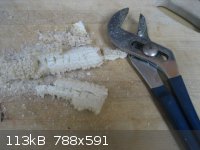 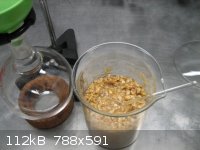
The single most important condition for a successful synthesis is good mixing - Nicodem
|
|
|
blogfast25
International Hazard
    
Posts: 10562
Registered: 3-2-2008
Location: Neverland
Member Is Offline
Mood: No Mood
|
|
Someone should contemplate recycling these things into baseball or cricket bats...
Look forward to reading about the rest of this synthesis! 
|
|
|
Ozone
International Hazard
    
Posts: 1269
Registered: 28-7-2005
Location: Good Olde USA
Member Is Offline
Mood: Integrated
|
|
Many seed hulls, particularly those from sunflower seeds, are especially rich in hemicellulose (primarily arabinoxylan with almost no cellulose). I
expect these to be excellent feedstock for a process like this. I might give it a shot after I get a kg or two of seed hulls.
Cheers,
O3
-Anyone who never made a mistake never tried anything new.
--Albert Einstein
|
|
|
Magpie
lab constructor
    
Posts: 5939
Registered: 1-11-2003
Location: USA
Member Is Offline
Mood: Chemistry: the subtle science.
|
|
Quote: Originally posted by Ozone  | ... sunflower seeds, are especially rich in hemicellulose (primarily arabinoxylan with almost no cellulose). I expect these to be excellent feedstock
for a process like this.
|
If this converts to arabinose it indeed ought to be a good feedstock & interesting to compare to the oat bran, corn cobs, and d-ribose that I have
used.
The steam distillation of the corncob hydrolysis was completed today. I ran it for 4 hours but it was pretty much finished after 3 hours. OrgSyn's
preparation says it will take 5-10 hours for their 1.5kg batch.
My yield was 7.5g. Scaled on OrgSyn's expected yield I should have obtained ~15.2 g. But my vastly smaller scale (0.076X) is likely a major factor
in my smaller yield.
Again the mash turned black after it started boiling. Pictures are shown below.
This completes my investigation of natural products for the preparation of furfural. If I want any more I'll use d-ribose as available from my
neighborhood health food store.
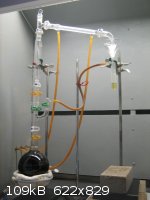 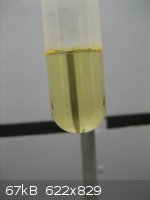
[Edited on 15-8-2011 by Magpie]
The single most important condition for a successful synthesis is good mixing - Nicodem
|
|
|
Magpie
lab constructor
    
Posts: 5939
Registered: 1-11-2003
Location: USA
Member Is Offline
Mood: Chemistry: the subtle science.
|
|
Wanting to do some chemistry this week, but nothing too challenging, I decided to purify my crude furfural and then make a derivative of same.
I took the combined lots of furfural that I had made from the various sugar and pentosans, which amounted to about 25mL of straw colored translucent
liquid, and vacuum distilled it. Pressure was 50mmHg using an aspirator with the resulting bp at 76C. Being a bit lazy I did not at first set up an
ebulliator and a Claisen extension. This proved to be a big mistake due to bumping and carryover so shutdown and reconfigured the right way. Yield
was 20mL of clear product with a pleasant aroma - I would call it that of "benzaldehyde light."
Using 1g of homemade semicarbazide, some Na acetate buffer, and 1.5mL of furfural I made the derivative furfural semicarbazone (an imine) according to
the method in Brewster. This crystallized out without any help from scratching or cooling. I recrystallized it from 95% ethanol, washing it with
same. A melting point was taken of the dried crystals (see picture); it melted at the literature (Wiki) value of 202C.
I find it interesting that furfural is aromatic. Also it is interesting that the terminal nitrogen of the semicarbazide is the only one (of 3)
capable of nucleophillic attack due to resonance.
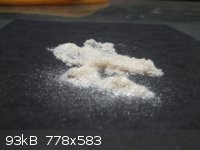
[Edited on 2-9-2011 by Magpie]
The single most important condition for a successful synthesis is good mixing - Nicodem
|
|
|
Random
International Hazard
    
Posts: 1018
Registered: 7-5-2010
Location: In ur closet
Member Is Offline
Mood: Energetic
|
|
Well, I tried dry distillation of sucrose before, until it carbonized. I obtained very small amount of liquid with the color just like this crude
furfural you made, though it had some oily caramel colored dot floating on that yellow liquid. The liquid smelled like burning sugar and caramel (and
I wonder why  ). My distillation apparatus was made from aluminium foil so it
was really bad one, a lot of fumes escaped. Maybe that liquid contained furfural too? ). My distillation apparatus was made from aluminium foil so it
was really bad one, a lot of fumes escaped. Maybe that liquid contained furfural too?
|
|
|
Nicodem
Super Moderator
      
Posts: 4230
Registered: 28-12-2004
Member Is Offline
Mood: No Mood
|
|
Good work Magpie!
Aromatic, but not much. If you think furane is much of an aromatic system, then you might be surprised at how easy it undergoes nucleophilic
additions. Particularly the reactions with amines and anilines are interesting as they give the corresponding pyrrole compounds from the furanes. For
example, furfural itself reacts with anilines such as p-nitroaniline to give 1-(4-nitrophenyl)-1H-pyrrole-2-carbaldehyde. This is a nice looking
heterocyclic product which can be further functionalized at the aldehyde group. References:
See DOI: 10.1071/CH9850953
Also, from CA 92:180923
| Quote: | Synthesis of 1-arylpyrrole-2-aldehydes from furfural and substituted aromatic amines.
Burmistrov, S. I.; Sannikova, V. M.
Voprosy Khimii i Khimicheskoi Tekhnologii (1979), 54 20-4.
Abstract: Pyrrolecarboxaldehydes I (R = 4-H2NSO2C6H4, Q, 4-nitro-1-naphthyl, 2,5- and 2,4-HO(O2N)C6H3, 2,3,5-HO(Cl)(O2N)C6H2) were prepd. in
23.2-87.6% yield by reaction of furfural with the resp. arom. amine. The semicarbazones, phenylhydrazones, 4-nitrophenylhydrazones,
2,4-dinitrophenylhydrazones, and azines of some I were also prepd. |
...and from CA 95:203666
| Quote: | Synthesis of 1-(4-nitrophenyl)pyrrole-2-aldehyde from furfural.
Baum, E.; Goldovskaya, T. E.; Kul'nevich, V. G.; Maiorova, O. V.
Khimiya Geterotsiklicheskikh Soedinenii (1981), (8), 1062-6.
Abstract: The condensation of furfural with p-O2NC6H4NH2 in different solvents (e.g., MeOH, EtOH, PrOH, DMF, or HOAc) contg. HCl gave 55%
pyrrolealdehyde I and 27% 2,3-bis[(4-nitrophenyl)amino]-4-cyclopentenone. Yields of up to 70% were obtained using methods described earlier (e.g.,
Liipke, 1939). |
...and briefly described in DOI: 10.1007/BF01042479
…there is a human touch of the cultist “believer” in every theorist that he must struggle against as being
unworthy of the scientist. Some of the greatest men of science have publicly repudiated a theory which earlier they hotly defended. In this lies their
scientific temper, not in the scientific defense of the theory. - Weston La Barre (Ghost Dance, 1972)
Read the The ScienceMadness Guidelines!
|
|
|
aliced25
Hazard to Others
  
Posts: 262
Registered: 31-7-2010
Member Is Offline
Mood: No Mood
|
|
Bagasse is going to be far easier to work with than corn cobs (given it is already shredded and readily available in most garden stores - it is used
as mulch). Rice husk is another easily (and cheaply) acquired source of xylose, there is a paper (here) on the extraction of xylose from Rice Husk/Hulls using 1N H2SO4. Making furfural from the sugar is going to be way easier given the lack of
bulk and the reduction in the amount of acid needed.
From a Knight of the Realm: "Animated movies are not just for kids, they're also for adults who do a lot of drugs." Sir Paul McCartney
|
|
|
Magpie
lab constructor
    
Posts: 5939
Registered: 1-11-2003
Location: USA
Member Is Offline
Mood: Chemistry: the subtle science.
|
|
I agree that it is good to reduce the bulk of the precursor as much as possible. Although expensive, I did this using OTC d-ribose. However, even
using this pure sugar the best yield I could get was 45%. When I tried it again I got exactly the same yield. A great deal of the precursor is just
turned to carbon.
The single most important condition for a successful synthesis is good mixing - Nicodem
|
|
|
Ozone
International Hazard
    
Posts: 1269
Registered: 28-7-2005
Location: Good Olde USA
Member Is Offline
Mood: Integrated
|
|
Just some notes on your alternative feedstocks:
Yes, but bagasse contains 50% w/w water and 2-4% residual cane juice; it is only 20-24% hemicellulose (most of which is arabinoxylan). It is also
recalcitrant. I would go for cellulosic ethanol then concentrate and work on the stillage (which contains all sorts of interesting things like
aconitic acid, your xylan, etc.)
NIST sugarcane bagasse (from my lab % w/w dry solids):
extractables: 4.4
Cellulose: 40.2
Hemicellulose: Xylan 21.8, Arabinan 1.8 and mannan 0.4
Lignin: Klason 22.3, AS 2.0
Ash: 4.0
Rice hulls come nice and dry, which is a plus for storage and compositionally simple. But, again, these are a rich cellulose source with a composition
(La. rice hulls, results from my lab) similar to:
extractables: 2.2
Cellulose: 33.0
Hemicellulose: Xylan 15.8, Arabinan 1.3 and mannan 0.0
Lignin: Klason 24.0, AS 2.7
Ash: 19.0
It should be mentioned that rice hulls are flame retardant (I had a hard time getting them to combust in a Parr bomb under 19 atm O2) and that the
huge amount of ash is part of the plant structure; it is at least 94 % silica.
Cheers,
O3
[Edited on 4-9-2011 by Ozone]
-Anyone who never made a mistake never tried anything new.
--Albert Einstein
|
|
|
blogfast25
International Hazard
    
Posts: 10562
Registered: 3-2-2008
Location: Neverland
Member Is Offline
Mood: No Mood
|
|
Very interesting data, O3. Also that point on > 94 % silica in ash, I wonder how that compares to most plant ashes...
|
|
|
Ozone
International Hazard
    
Posts: 1269
Registered: 28-7-2005
Location: Good Olde USA
Member Is Offline
Mood: Integrated
|
|
Yes, I thought so, too. When totally combusted to ash, you get a *fine* pure-white silica. I have thought about trying it out (as a stationary phase)
in a column.
It would be cool if we could source relatively high-grade silica from rice hulls.
Cheers,
O3
-Anyone who never made a mistake never tried anything new.
--Albert Einstein
|
|
|
watson.fawkes
International Hazard
    
Posts: 2793
Registered: 16-8-2008
Member Is Offline
Mood: No Mood
|
|
Certain species of
horsetail are known as "scouring rushes" because of the high content of silicates; they're a naturally occurring plant abrasive. I would be curious to
know what happens when you ash these, but not curious enough to acquire the gear just for this one experiment.
|
|
|
aliced25
Hazard to Others
  
Posts: 262
Registered: 31-7-2010
Member Is Offline
Mood: No Mood
|
|
Here is some more - interestingly enough HCl or H3PO4 are the acids of choice for this procedure - with steam distillation being the preferred way of
isolating the product from the 'strong' acid before it degrades too much (I suspect your choice of acid would be responsible for much of the
charring).
What would be nice is a decent, completely otc route to THF, pyrrole, porphyrins, etc.
[Edited on 12-3-2012 by aliced25]
Attachment: Andrews.Milroy.The.MicroDetermination.of.Pentoses.Free.and.Combined.pdf (474kB)
This file has been downloaded 1282 times
Attachment: Duncan.Determination.of.Furfural.pdf (442kB)
This file has been downloaded 985 times
Attachment: Hockett.Guttag.Smith.The.Production.of.Furfural.from.D.Lyxose.and.D.Ribose.pdf (299kB)
This file has been downloaded 829 times
Attachment: Reeves.Munro.Quantitative.Determination.of.Pentoses.pdf (409kB)
This file has been downloaded 788 times
Attachment: Trimble.Dunlop.Recovery.of.Furfural.from.Aqueous.Solutions.pdf (226kB)
This file has been downloaded 749 times
Attachment: Youngburg.Studies.on.Pentose.Metabolism.II.A.Micromethod.for.the.Determination.of.Pentoses.and.Pentosans.pdf (354kB)
This file has been downloaded 895 times
From a Knight of the Realm: "Animated movies are not just for kids, they're also for adults who do a lot of drugs." Sir Paul McCartney
|
|
|
niertap
Hazard to Self
 
Posts: 76
Registered: 5-8-2011
Member Is Offline
Mood: hyper-conjucated
|
|
Fructose will give one of the best yields. Acid catalyzed hydrolysis of sucrose should give a good supply of it. I don't really think anyone knows
why frustose will give a 75% yield or something like that.
You may have to add a little silica jell, though. It seems to facilitate reactions with diols or more ols. When put through GCMS the polyols will
kind of rip little bits of the column out.
however if you put any fructose containing mixture(ex. fruit juice) through it, the fructose will read as furfural.
I believe some organization was trying to find a great way to make it for use as an alternative fuel source. Fructose all the way.
Fructose
all the way
Ignorance is bliss
Outliers in life are modeled by chemical kinetics
|
|
|
bbartlog
International Hazard
    
Posts: 1139
Registered: 27-8-2009
Location: Unmoored in time
Member Is Offline
Mood: No Mood
|
|
| Quote: | | Acid catalyzed hydrolysis of sucrose should give a good supply of it. |
Under what conditions, using what acid? One possible outcome of such hydrolysis is levulinic and formic acids (and plenty of black gunk in an
insoluble cake), per Organic Syntheses: http://www.orgsyn.org/orgsyn/prep.asp?prep=CV1P0335
Now maybe with less water, or a dehydrating acid (such as sulfuric acid), or other conditions... do you have a reference?
The less you bet, the more you lose when you win.
|
|
|
Boffis
International Hazard
    
Posts: 1836
Registered: 1-5-2011
Member Is Offline
Mood: No Mood
|
|
This is a long dormant thread but I think it is worth reviving. Over the last few years, each spring, a flowering cherry tree in our garden weeps a
clear liquid that quickly turns rubbery and finally turns into a hard glassy gum. The soft material swells in water but once hard it is surprisingly
resistant to cold water. Some digging around on the internet shows that this type of gum is rich in pentose sugars. I initially tried to extract the
arabinose but it is very difficult to isolate it as a crystalline solid so I decided to see if I could recover any furfural from it by distillation
with acid. The result was 5.5g of pale straw coloured furfural from 58g of gum. I suspect a better yield could be obtained directly from the gum but I
did a lot of acid hydrolysis and processing on the material before I tried to recover the furfural. I estimate that the final syrup contained about
38g of solids. I will try again if we get another crop this coming spring.
After this modest success I tried the same process on 25g of xylose and then the same weight of ribose. With xylose I got about 8.9g which is about
55% yield and with D-ribose I got 63% yield. Looking at the literature these are good yields.
I am currently investigating the possibility of using other sources such a sodium gluconate which can be oxidized to arabinose with H2O2 and
hypochlorite oxidation of glucosamine which also yields arabinose.
I am in the process of writing a detailed article for the prebulication section; maybe get it out today.
|
|
|
DraconicAcid
International Hazard
    
Posts: 4278
Registered: 1-2-2013
Location: The tiniest college campus ever....
Member Is Offline
Mood: Semi-victorious.
|
|
Nice! (Now oxidize it to an acid and make some esters!)
Please remember: "Filtrate" is not a verb.
Write up your lab reports the way your instructor wants them, not the way your ex-instructor wants them.
|
|
|
Boffis
International Hazard
    
Posts: 1836
Registered: 1-5-2011
Member Is Offline
Mood: No Mood
|
|
Ethyl furoate, what does that smell like  ? ?
|
|
|
DraconicAcid
International Hazard
    
Posts: 4278
Registered: 1-2-2013
Location: The tiniest college campus ever....
Member Is Offline
Mood: Semi-victorious.
|
|
Only one way to find out.....
Please remember: "Filtrate" is not a verb.
Write up your lab reports the way your instructor wants them, not the way your ex-instructor wants them.
|
|
|
Fery
National Hazard
   
Posts: 990
Registered: 27-8-2019
Location: Czechoslovakia
Member Is Offline
|
|
Definitely worth trying it! I do not know why the same substance has 2 different CAS numbers and contradictory scent information:
http://www.thegoodscentscompany.com/data/rw1433881.html
Name: ethyl furan-2-carboxylate
CAS Number: 1335-40-6
Recommendation for ethyl furoate usage levels up to: not for fragrance use
Melting Point: 33.00 to 36.00 °C. @ 760.00 mm Hg
Boiling Point: 196.00 °C. @ 760.00 mm Hg
http://www.thegoodscentscompany.com/data/rw1022631.html
Name: ethyl furan-2-carboxylate
CAS Number: 614-99-3
Odor Type: balsamic fruity floral orchid
Melting Point: 35.00 to 37.00 °C. @ 760.00 mm Hg
Boiling Point: 196.00 °C. @ 760.00 mm Hg
Sigma-Aldrich catalogue uses only the second CAS number and the first one is not present there.
|
|
|
| Pages:
1
2
3 |